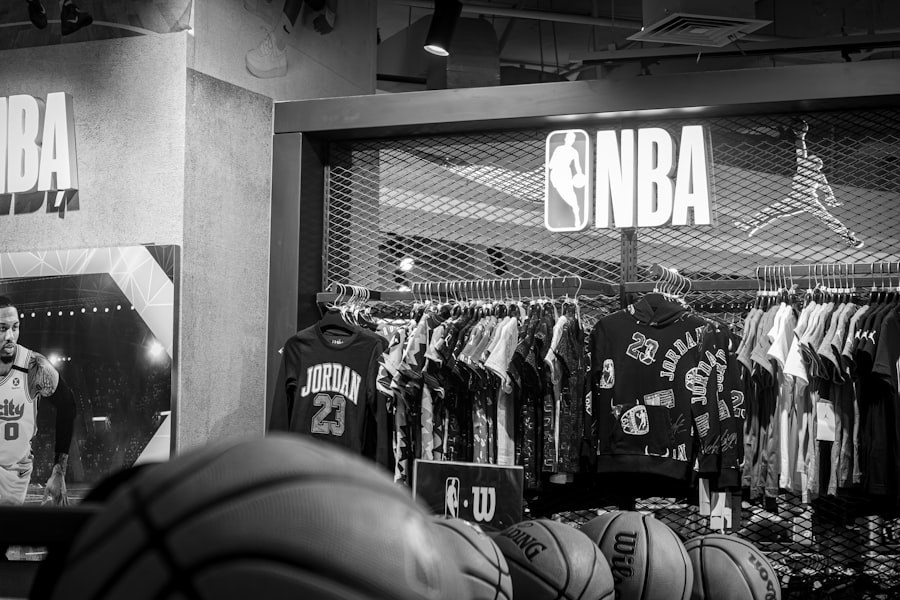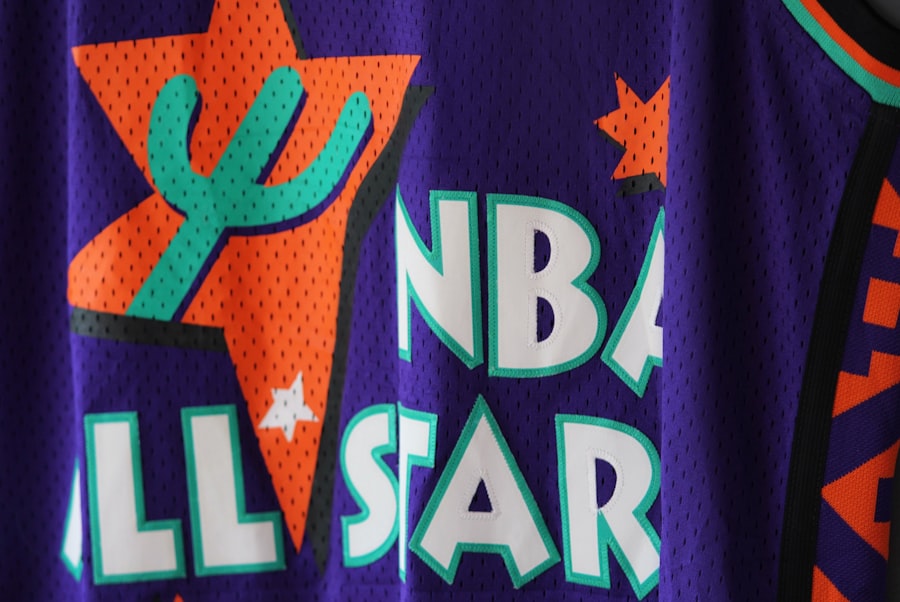The National Basketball Association (NBA) has long been a pioneer in the realm of sports marketing and branding. As the league has evolved, so too have its revenue streams, with jersey advertising emerging as a significant component of its financial landscape. The introduction of jersey sponsorships in the NBA marks a transformative shift in how teams generate income and engage with fans.
This initiative, which began in the 2017-2018 season, allows teams to display corporate logos on their uniforms, creating a new avenue for partnerships and brand visibility. The move has not only changed the aesthetic of the jerseys but has also redefined the relationship between teams, sponsors, and fans. The decision to incorporate advertising on jerseys was not made lightly.
It reflects broader trends in sports where teams are increasingly looking for innovative ways to enhance their financial viability. In a league where player salaries are soaring and operational costs are rising, jersey advertising offers a solution that aligns with the interests of both teams and sponsors. This initiative has sparked discussions about the commercialization of sports and how it impacts the identity of teams and their connection with fans.
As we delve deeper into this topic, it becomes clear that jersey advertising is more than just a financial strategy; it is a reflection of the evolving landscape of professional sports.
Key Takeaways
- Jersey advertising has become a significant new revenue stream for NBA teams.
- Sponsorship deals play a crucial role in securing jersey advertising partnerships.
- NBA teams are increasingly embracing jersey ads to boost their financial growth.
- Challenges include fan backlash and maintaining the league’s brand integrity.
- Strategic approaches can maximize revenue potential from jersey advertising in the future.
The Impact of Jersey Advertising on Revenue Generation
The financial implications of jersey advertising for NBA teams are profound. By allowing corporate logos to be displayed on uniforms, teams can tap into a lucrative source of revenue that was previously untapped. According to reports, teams can earn anywhere from $5 million to $20 million annually from jersey sponsorship deals, depending on the market size and the popularity of the team.
This influx of cash can be pivotal for franchises, particularly those in smaller markets or those looking to invest in player development, facilities, or community outreach programs. Moreover, jersey advertising has the potential to enhance overall league revenues. As more teams adopt this model, the cumulative effect can lead to increased broadcasting rights fees and greater interest from advertisers looking to associate their brands with successful franchises.
The visibility that comes from having a logo on a team’s jersey extends beyond just the game itself; it permeates social media, merchandise sales, and even international markets where NBA games are broadcasted. This multifaceted exposure creates a ripple effect that can significantly boost a team’s bottom line.
How NBA Teams are Embracing Jersey Advertising

NBA teams have approached jersey advertising with varying degrees of enthusiasm and creativity. Some franchises have formed partnerships with local businesses, while others have aligned themselves with global brands that resonate with their fan base. For instance, the Philadelphia 76ers made headlines when they partnered with StubHub, a ticket resale platform, marking one of the first major jersey sponsorships in the league.
This partnership not only provided financial support but also enhanced the team’s connection with fans who frequently engage in ticket transactions. In contrast, teams like the Boston Celtics have opted for sponsorships that reflect their storied history and community values. Their partnership with General Electric (GE) was not just about financial gain; it was also about aligning with a brand that has deep roots in Massachusetts.
Such strategic partnerships allow teams to maintain their identity while also benefiting from the financial support that comes with jersey advertising. The creativity displayed by teams in selecting sponsors demonstrates an understanding of their audience and a commitment to enhancing the overall fan experience.
The Role of Sponsorship Deals in Jersey Advertising
| Metric | Description | Example Value | Impact on Jersey Advertising |
|---|---|---|---|
| Number of Sponsorship Deals | Total count of active sponsorship agreements involving jerseys | 150 | Higher number increases brand visibility on jerseys |
| Average Sponsorship Duration | Length of time (in years) sponsorship deals typically last | 3 years | Longer deals provide sustained advertising exposure |
| Brand Exposure Increase | Percentage increase in brand recognition due to jersey sponsorship | 35% | Significant boost in brand awareness through jersey placement |
| Audience Reach | Estimated number of viewers exposed to jersey advertisements per event | 500,000 | Large audience reach enhances advertising effectiveness |
| Revenue from Sponsorship | Average annual income generated from jersey sponsorship deals | 1,200,000 | Major source of funding for teams and advertising campaigns |
| Fan Engagement Rate | Percentage of fans interacting with sponsored jersey content | 22% | Higher engagement leads to better brand loyalty |
Sponsorship deals are at the heart of jersey advertising in the NBThese agreements are often complex and multifaceted, involving not just logo placement but also promotional activities, community engagement initiatives, and digital marketing strategies. Teams negotiate these deals based on various factors, including market size, team performance, and brand alignment. For example, the Los Angeles Lakers’ partnership with Wish, an online shopping platform, reflects both the team’s global appeal and Wish’s desire to reach a broader audience through association with one of basketball’s most iconic franchises.
The negotiation process for these sponsorships can be intricate, as teams must balance financial considerations with brand compatibility. A successful partnership goes beyond mere logo placement; it involves creating a narrative that resonates with fans and enhances their connection to both the team and the sponsor. This is particularly important in a league where fan loyalty is paramount.
Teams that effectively leverage their sponsorship deals can create unique marketing campaigns that engage fans both on and off the court, ultimately leading to increased merchandise sales and enhanced brand loyalty.
Challenges and Criticisms of Jersey Advertising in the NBA
Despite its potential benefits, jersey advertising has not been without its challenges and criticisms. One major concern is the potential dilution of team identity. Fans often have strong emotional connections to their teams, and the introduction of corporate logos on jerseys can be perceived as a departure from traditional values.
Critics argue that this commercialization may undermine the authenticity of sports and create a disconnect between teams and their supporters. The visual impact of logos on jerseys can also lead to debates about aesthetics and whether they detract from the classic designs that fans cherish. Additionally, there are concerns about over-commercialization in sports.
As more leagues adopt similar practices, there is a risk that fans may become desensitized to advertising messages, leading to diminished returns for sponsors. The challenge lies in finding a balance between generating revenue through sponsorships while maintaining the integrity of the sport. Teams must navigate these waters carefully to ensure that they do not alienate their fan base while pursuing new revenue opportunities.
The Future of Jersey Advertising in the NBA

Looking ahead, jersey advertising is poised to become an even more integral part of the NBA’s business model. As technology continues to evolve, there are opportunities for dynamic advertising solutions that go beyond static logos on jerseys. For instance, augmented reality (AR) could allow fans to interact with advertisements in innovative ways during games or through mobile applications.
This could create immersive experiences that enhance fan engagement while providing sponsors with unique marketing opportunities. Moreover, as global markets continue to expand, NBA teams may seek international partnerships that reflect their diverse fan bases. This could lead to jersey sponsorships with brands from emerging markets, further diversifying revenue streams.
The potential for cross-promotional campaigns that leverage social media platforms could also enhance visibility for both teams and sponsors alike. As teams explore these avenues, they will need to remain attuned to fan sentiment and ensure that any new initiatives align with their core values.
Strategies for Maximizing Revenue through Jersey Advertising
To maximize revenue through jersey advertising, NBA teams must adopt strategic approaches that consider both short-term gains and long-term brand building. One effective strategy is to conduct thorough market research to identify potential sponsors whose values align with those of the team and its fan base. By selecting partners that resonate with fans, teams can create authentic narratives that enhance engagement and drive sales.
Additionally, teams should leverage digital platforms to amplify their sponsorship deals. Social media campaigns that highlight partnerships can create buzz around jersey advertisements and encourage fan interaction. For example, engaging content such as behind-the-scenes videos or player endorsements can humanize sponsors and foster a sense of community among fans.
Furthermore, integrating sponsorships into game-day experiences—such as special promotions or giveaways—can enhance visibility and create memorable moments for attendees.
The Potential of Jersey Advertising for NBA Revenue Growth
The introduction of jersey advertising in the NBA represents a significant evolution in how teams approach revenue generation and brand partnerships. While challenges exist regarding fan perception and over-commercialization, the potential benefits are substantial. As teams continue to embrace this trend and explore innovative strategies for maximizing revenue through sponsorship deals, they will likely find new ways to engage fans while enhancing their financial stability.
The future of jersey advertising holds promise as technology advances and global markets expand. By carefully navigating this landscape and prioritizing authentic connections with fans, NBA teams can harness the full potential of jersey advertising as a key driver of revenue growth in an increasingly competitive sports environment.



